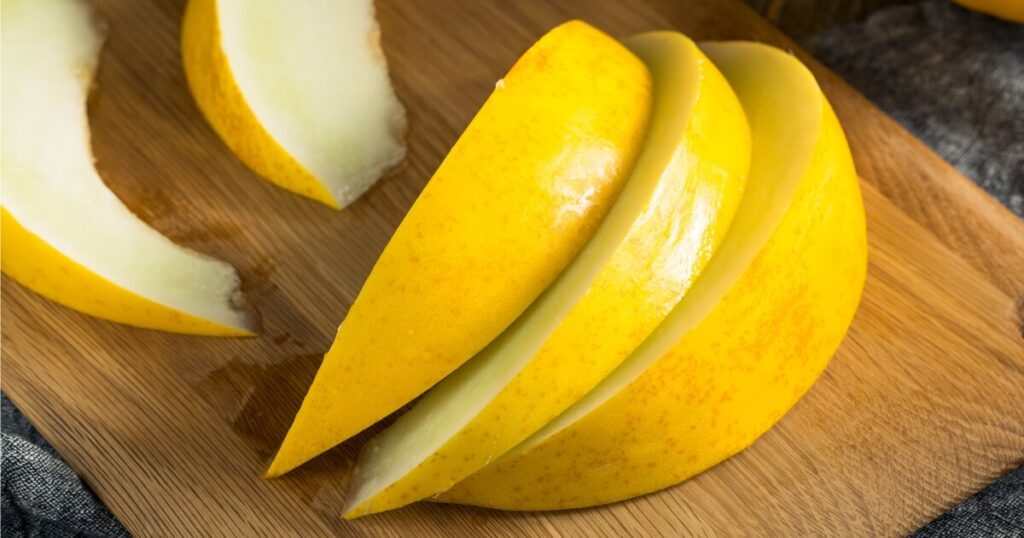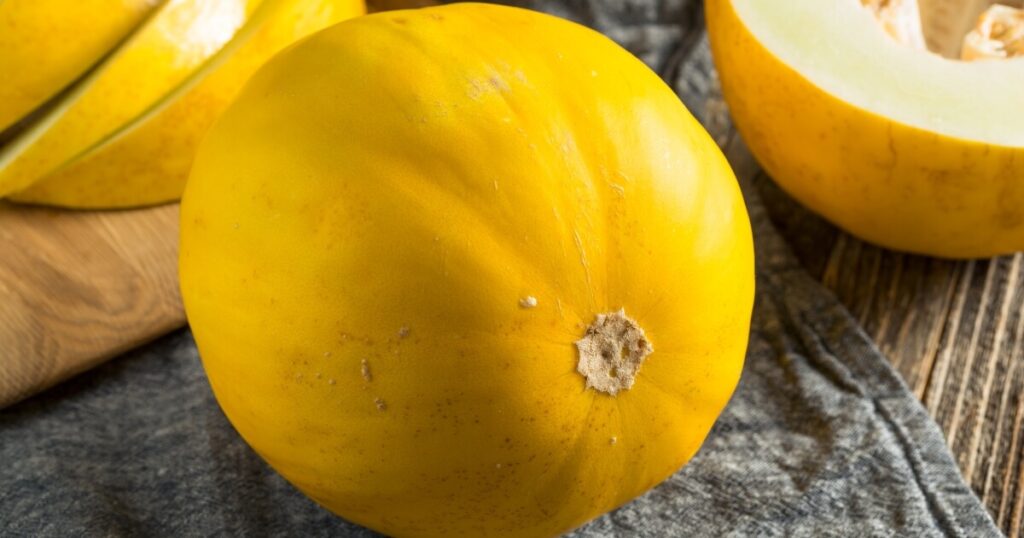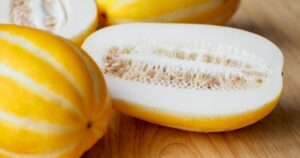Meet the Canary Melon, a bright, sunshine-yellow fruit that’s as delightful to eat as it is to look at. With its vibrant hue and slightly waxy exterior, this melon variety is a sight to behold. It’s a summer favorite, best enjoyed when the sun is high and the days are warm.
The taste of a Canary Melon is a unique experience. It offers a sweet and slightly tangy flavor, with a hint of musk that sets it apart from other melons. The firm, pale orange flesh is reminiscent of a cantaloupe, yet it holds its own distinctive taste.
In the following sections, we’ll delve deeper into the world of Canary Melons. We’ll explore its taste in more detail, discuss its texture and appearance, and even share some tips on enjoying this delightful fruit best. So, if you’re ready to discover something new, read on!
How Do Canary Melons Taste?
Canary Melons are a feast for the senses, especially when it comes to their taste. They have a sweet flavor that’s not overpowering, balanced with a slight tanginess that adds a refreshing note. This balance makes the Canary Melon a versatile fruit that can complement a variety of dishes.

One of the unique aspects of the Canary Melon’s taste is a subtle hint of musk. This musky undertone adds a layer of complexity to the fruit’s flavor profile, making each bite an exciting experience. It’s a distinctive yet familiar taste, reminiscent of a cantaloupe but with its own unique twist.
The flavor of the Canary Melon is best described as a symphony of sweet, tangy, and musky notes. Each bite is a delightful surprise, making this melon a must-try for any fruit lover.
Varieties Of Canary Melons
Canary Melons come in a few different varieties, each with its own unique characteristics:
- Classic Canary Melon: This is the most common variety, known for its bright yellow skin and sweet, slightly tangy flavor. It has a hint of musk that adds complexity to its taste.
- Golden Canary Melon: This variety is similar to the classic Canary Melon but has a deeper golden color. Its flavor is a bit sweeter, making it a favorite among those who prefer sweeter fruits.
- Tropical Canary Melon: This variety is grown in tropical regions and has a slightly different flavor profile. It’s sweeter and juicier than the classic variety, with a more pronounced muskiness.
Comparing Canary Melons With Other Fruits
Canary Melons can be compared with several other fruits in terms of taste and texture:
- Honeydew Melon: Honeydew Melons have a similar sweet flavor but lack the tanginess and muskiness of Canary Melons. Their flesh is also more pale green than the pale orange of Canary Melons.
- Cantaloupe: Cantaloupes are sweeter and have a more pronounced musky flavor than Canary Melons. They also have a different texture, with a more netted skin and orange flesh.
- Watermelon: Watermelons are juicier and have a more watery texture compared to Canary Melons. Their flavor is also sweeter and less complex.
- Pear: Pears have a similar sweet and slightly tangy flavor but lack the muskiness of Canary Melons. Their texture is also different, being more grainy and less juicy.
Do Canary Melons Taste Good?
Canary Melons are a delightful treat for the taste buds, but like any fruit, whether they taste good can depend on personal preference and the fruit’s freshness and ripeness.
If you enjoy fruits with a balance of sweet and tangy flavors, you’ll likely find Canary Melons to your liking. Their subtle muskiness adds a unique twist, refreshing them from more common melons. Their firm, crisp flesh also provides a satisfying crunch, adding to the overall eating experience.
However, the taste of a Canary Melon can vary depending on its ripeness. A perfectly ripe Canary Melon is sweet and flavorful, while an underripe one can be bland and lack the characteristic muskiness. On the other hand, an overripe melon can become overly soft and lose its refreshing crunch.
Eating a Canary Melon raw is the best way to enjoy its unique flavor. It can be a refreshing snack on a hot day or a sweet ending to a meal. Cooking a Canary Melon is less common but can be used in certain recipes. Keep in mind that cooking may alter the flavor and texture of the melon.
As for freezing, Canary Melons can be frozen, which is usually done when using the melon in smoothies or other blended drinks. Freezing can change the texture of the melon, making it less crisp, but it can be a good way to preserve the melon’s flavor when it’s in season.
In conclusion, whether a Canary Melon tastes good can depend on various factors. But with its unique flavor and satisfying texture, it’s worth trying.
What Does Canary Melon Look Like?
Canary Melons are quite distinctive in appearance, which makes them relatively easy to identify in a grocery store or farmers’ market.

They have a bright yellow, slightly waxy skin that stands out among other fruits. The shape of a Canary Melon can vary from oval to oblong, but it’s typically more elongated than other melon varieties.
You’ll find pale orange to cream-colored flesh inside when you cut open a Canary Melon. The center of the melon contains a hollow cavity filled with small, white seeds. The flesh is firm and crisp, similar to that of honeydew or cantaloupe.
When buying a Canary Melon, there are a few things to look out for to ensure you’re getting a good one. First, the melon should feel heavy for its size, which indicates that it’s juicy and ripe. The skin should be uniformly yellow without any green or white spots. A ripe Canary Melon will also have a slightly waxy feel and a sweet, fruity aroma.
Avoid Canary Melons with soft spots, bruises, or cuts, as these are signs of damage or overripeness. Also, steer clear of melons that are too hard or have a greenish hue, as these are likely underripe and won’t have the sweet, flavorful taste that Canary Melons are known for.
Do Canary Melons Have Seeds?

Yes, Canary Melons do have seeds. When you cut open a Canary Melon, you’ll find a hollow cavity in the center that’s filled with small, white seeds. These seeds appear similar to those found in other melon varieties, such as cantaloupes or honeydews.
While the seeds of the Canary Melon are technically edible, they are usually scooped out and discarded before the melon is eaten. This is because the seeds have a slightly bitter taste that can detract from the sweet flavor of the melon’s flesh.
Canary Melon FAQs
What is the best way to eat a Canary Melon?
Canary Melons are best enjoyed fresh. You can simply cut the melon into slices or cubes and eat it as is. Chilling the melon before serving can enhance its refreshing taste. For a twist, you can also try drizzling a bit of honey or lime juice over the melon to highlight its sweet and tangy flavor.
How can you tell if a Canary Melon is ripe?
A ripe Canary Melon will have a slightly waxy feel and a sweet, fruity aroma. The skin should be uniformly yellow without any green or white spots. The melon should also feel heavy for its size, indicating that it’s juicy and ripe.
What does a Canary Melon taste like?
Canary Melons have a sweet and slightly tangy flavor with a subtle hint of musk. The taste is a unique blend that sets it apart from other melons. The flesh is firm and crisp, satisfying each bite’s crunch.
How do you store a Canary Melon after cutting it?
After cutting a Canary Melon, store the leftover pieces in an airtight container in the refrigerator. This will help keep the melon fresh and prevent it from drying out. It’s best to consume the cut melon within a few days for the best taste and texture.


